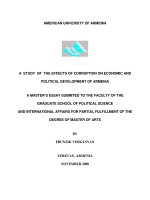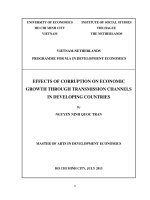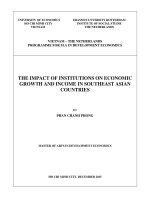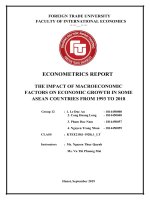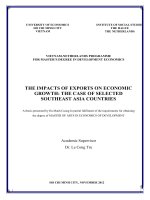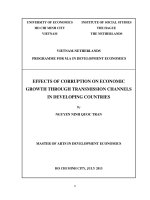The effect of corruption on economic growth in southeast asia countries
Bạn đang xem bản rút gọn của tài liệu. Xem và tải ngay bản đầy đủ của tài liệu tại đây (1.55 MB, 87 trang )
UNIVERSITY OF ECONOMICS
HO CHI MINH CITY
VIETNAM
INSTITUTE OF SOCIAL STUDIES
THE HAGUE
THE NETHERLANDS
VIETNAM - NETHERLANDS
PROGRAMME FOR M.A IN DEVELOPMENT ECONOMICS
THE EFFECT OF CORRUPTION ON
ECONOMIC GROWTH IN ASIAN COUNTRIES
BY
LE KIM DUNG
MASTER OF ARTS IN DEVELOPMENT ECONOMICS
HO CHI MINH CITY, Dec 2016
UNIVERSITY OF ECONOMICS
HO CHI MINH CITY
VIETNAM
INSTITUTE OF SOCIAL STUDIES
THE HAGUE
THE NETHERLANDS
VIETNAM - NETHERLANDS
PROGRAMME FOR M.A IN DEVELOPMENT ECONOMICS
THE EFFECT OF CORRUPTION ON
ECONOMIC GROWTH IN ASIAN COUNTRIES
A thesis submitted in partial fulfillment of the requirements for the degree of
MASTER OF ARTS IN DEVELOPMENT ECONOMICS
BY
LE KIM DUNG
Academic supervisor
Dr. TRUONG DANG THUY
HO CHI MINH CITY, Dec 2016
I. CERTIFICATION
I confirm that this paper, namely “The effect of corruption on economic growth in
Asian countries” is my own work. Where material has been used from other sources
it has been properly acknowledged and referenced. If this statement is untrue I
understand that I will have committed an assessment offence.
I have read the Regulations of Vietnam – Netherlands Programme for M.A In
Development Economics and I am aware of the potential consequences of any
breach of them.
Signature:
Name: Le Kim Dung
Date: Ho Chi Minh City, Dec 2016
II. ACKNOWLEDGEMENT
I would like to express my gratitude to interesting and extensive Vietnam–
Neitherlands Master Program in Development Economics, as well as honest thanks
to many people who built and developed this program such as management board,
lecturers, tutors, and librarians. Fulfillment this course, I acquired useful
knowledge, approached new things, were straightforward to expess ideas.
I would like to extend my special thanks to Dr. Truong Dang Thuy, the academic
supervisor who always read and correct my thesis carefully. His valuable
comments, guidances, and encouragement help me to improve the quality of my
thesis and complete it timely.
I also would like to take this opportunity to express my thanks to Dr. Nguyen Trong
Hoai, Dr. Pham Khanh Nam, other professors, tutors and course co-instructors of
Economics University who, through their valuable lectures and advices, help me
during the course.
Finally, many thanks and gratefulness are given to my dear family, my warm
friends for their encouragement in many ways that strongly support me during my
study stage.
III. CONTENTS
Certifications………………………………………………………………………………..
I
Acknowledment...................................................................................................................... II
Contents…………………………………………………………………………………
III
List of tables………………………………………………………………………………. IV
List of figures.......................................................................................................................... V
Abstract…………………………………………………………………………………
1
CHAPTER 1: INTRODUCTION............................................................................................ 2
1.1 Research problem ................................................................................................................ 2
1.2 Research objectives and research questions ........................................................................ 5
1.2.1 Research objectives .................................................................................................... 5
1.2.2 Research questions ..................................................................................................... 5
1.3 Thesis Structure ................................................................................................................... 5
CHAPTER 2: LITERATURE REVIEW ............................................................................... 7
2.1 Theoretical concepts related to economic growth and corruption ........................................ 7
2.2 Effect of corruption on economic growth: theoretical literatures ......................................... 9
2.3 Effect of corruption on economic growth: empirical studies ............................................ 11
2.3.1 The single equation approach ................................................................................... 11
2.3.2 The system of equations approach ........................................................................... 13
CHAPTER 3: METHODOLOGY AND DATA .................................................................. 21
3.1 General methods ................................................................................................................. 21
3.1.1 Conceptual framework for the study ........................................................................ 21
3.2 Research models and econometric methodology................................................................ 25
3.2.1 Research models ....................................................................................................... 26
3.2.2 Econometric methodology: ....................................................................................... 29
3.3 Data .................................................................................................................................... 31
CHAPTER 4: ESTIMATION RESULT ANALYSIS AND DISCUSSION ...................... 34
4.1 Descriptive statistics analysis on the dataset ...................................................................... 34
4.2 Regression results and discussion ....................................................................................... 42
4.2.1 Effects of corruption on economic growth directly.................................................. 42
4.2.2 Effects of corruption on economic growth indirectly through transmitions
channels .................................................................................................................................... 44
CHAPTER 5: CONCLUSION, LIMITATION AND FUTURE RESEARCH ................. 52
5.1 Conclusion ......................................................................................................................... 52
5.2 Limitations and future research ......................................................................................... 52
5.2.1 Limitations ................................................................................................................ 52
5.2.2 Suggestion for future research .................................................................................. 53
REFERENCES…………………………………………………………………….…...55
APPENDIX
Appendix A : Summary of empirical studies………………………………….…….63
Appendix B : Sample of countries.………………………………………………….68
Appendix C : Regression results…………………………………………………….69
IV. LIST OF TABLES
Table 1: Expected sign of selected variables………………………….………….……….25
Table 2: Model specification of growth and transmission channel equations……….……29
Table 3: Summary of Variables ……………………………………………….…………32
Table 4: Descriptive statistics and correlations of selected variables………….………….36
Table 5: Correlations of selected variables…………………………………….………….37
Table 6: Results of Pooled OLS, Fixed effect model (FEM), and Random effect model
(REM) in GDP regression model (Model 1)………………………………………………42
Table 7: Results of 3SLS regression in a system of structural equations…………………46
Table 8: Consequence of Corruption on Economic growth through transmission
channels………………………………………………………………………………..…..47
V. LIST OF FIGURES
Figure 1: The effect of Corruption on Economic growth………………………………….21
Figure 2: Scatter graph between Economic growth (GDP) and Corruption (CPI)………...37
Figure 3: Scatter graph between Economic growth (GDP) and Political Instability
(PI)…………………………………………………………………………………………38
Figure 4: Scatter graph between Economic growth (GDP) and Investment (I)…………..38
Figure 5: Scatter graph between Economic growth (GDP) and Human Capital (HC)……39
Figure 6: Scatter graph between Economic growth (GDP) and Trade Openness (OPEN)..39
Figure 7: Scatter graph between Economic growth (GDP) and Government Expenditure
(GOV)…………………………………………………………………………………..…39
Figure 8: Scatter graph between Corruption (CPI) and Investment (I)………………...…40
Figure 9: Scatter graph between Corruption (CPI) and Human Capital (HC)………….…40
Figure 10: Scatter graph between Corruption (CPI) and Political Instability (PI)……...…41
Figure 11: Scatter graph between Corruption (CPI) and Government Expenditure (GOV)41
Figure 12: Scatter graph between Corruption (CPI) and Trade Openness (OPEN)……….41
ABSTRACT
Many theoretical and empirical studies suggest that economic growth depends on
various factors such as physical capital, human capital, openness to trade,
macroeconomic conditions, corruption perceptions, education, and population
growth. This study focuses on summarizing these studies and examining the total
impact of corruption on economic growth. Based on panel data included thirty
Asian countries over the observation period 1996-2014, this paper applies both
ordinary least square (OLS) technique and three-stages least square (3SLS)
technique to determine how corruption impacts on economic growth directly and
indirectly through five possible transmission channels: investment, human capital,
political instability, government expenditure, and the openness of international
trade. In consistency with findings of the previous empirical researches, this paper
concludes that the effect of corruption on the economic development of thirty Asian
countries is significantly negative.
Keywords: economic growth, corruption, investment, human resource, political
instability, government expenditure, openness to trade.
LE KIM DUNG
Page 1
CHAPTER 1: INTRODUCTION
1.1 Research problem
During the past few decades, various researchers have tried to identify what are the
most important determinants of economic growth, and why some nations have
experienced quick long-term income growth rates while others have not. A
fundamental cause for this study is the lack of a final agreement about the engine of
growth because there are many factors that influence the development of the
economy. Indeed, two most popular growth theories, the neoclassical growth theory
by Solow (1956) with the cruciality of investment activities and the endogenous
growth theory by Romer (1986) and Lucas (1988) focusing on labor and the
capacity of innovation lead to various extensions and country developments later.
These developments raise a big discussion about the most important sources of
growth. While some researchers refer to factors such as labor, capital, investment,
technological progress, government spending, and openness of trade economic
freedom; the others are referring to institutions, democracy, rule of law, geography
factors, and corruption.
In searching for the important growth determinants, a lot of economists focus on
corruption, for example, Left (1964), Becker (1968), Lui (1985), Manion (1996),
Kaufmann and Wei (1999), Haque and Kneller (2009), Mohamed Dribi (2013),
Diaby and Sylwester (2014), Pak Hung Mo (2014). Even then, their lituratures have
not approached to the last concord about the effects of corruption on economic
growth. Some papers stated that with a suitable level of corruption, the correlation
between corruption and economic development is positive. In the country that has
wordiness, sophisticated, unclear administrative procedures, corruption is needed
for completing an economic operation quickly such as building a house, application
for licenses, organizing a company. It can shorten businessman wasting time for
queuing in line and paperwork (Lui, 1985). The “efficient grease” hypothesis stated
that corruption improve economic effiency, and firms give more bribes should have
approach capital with lower cost easily. Corruption is also a side effect of an
LE KIM DUNG
Page 2
emerging country and a free open market economy. Manion (1996) clarified that: to
avoid costly delays, applicants make corrupt overpayments to officers for enterprise
licenses to which they are fully entitled. In making such payments, bureaucrats
enhance their income base. When administration staff have high income, they spend
more for goods and services so the economy will grows. In addition, undeveloped
states can not deal with corruption without having achieved the high level of
economic development necessary. If not, the governmet will spend a lot of labor
force, time, and money to reduce corruption.
However, a numerous evidences on significant negative corellation between
corruption and economic growth are showed in many empirical researches after
managing the vital determinants of economic like government expenditure, human
capital, trade openness, investment, political instability, including Mauro (1995),
Mauro (1996), Pak Hung Mo (2001), Pellegrini and Gerlagh (2004), Lorentzen, Mc
Milan and Wacziarg (2008), Pellegrini (2011), Marie Chene (2014). For instance,
the causual association between corruption and growth has been investigated in the
study of Mohamed Dridi (2013) by employing the Channel Methodology (method
which was developed by Tavares and Wacziarg in 2011). Based on cross-country
data including 82 developed and developing countries for a period of 1980-2002,
the author found that corruption affects the economic growth negatively. The
empirical result indicated that one point increased in the corruption index will
generate 0.9 percent decreased in the annual growth rate via human resources,
government spending, investment, inflation, political condition, and openness. The
paper futher concluded that human resources and political situation are the most
crucial transmission channel through which corruption transmits its negative impact
on economic growth. Unlike Mohamed Dridi, Mo (2001) used the decomposition
method and found that the political instability accounts for 53 percent of the total
corruption effect on growth. Furthermore, using cross-coutry regression, Mauro
(1996) showed the strong negative effects of corruption on growth in 94 countries
with observations period from 1960 to 1985. Mauro (1996) concluded that
LE KIM DUNG
Page 3
corruption reduces investment, especially in private sector, and declines the
government expenditures in developing education seen as the vitual element of
growth. With the data from Global Competiveness Report Serveys in the year 1996
and 1997, based on Stackelberg game theory, Kaufmann and Wei (1999) checked
the relationship between bribe payment and effective bureaucratic molestation.
They found that no evidences support for the “speed money” hypothesis, expressed
differently, they refuted “efficient grease” thesis, so corruption reduces economic
growth.
Besides, the correlation between corruption and economic growth is still uncertain
in some findings from previous papers (Andvig and Moene, 1990; Ehrlich and Lui,
1999; Aidt et al, 2008; Haque and Kneller, 2009; Leite and Weidmann, 1999). By
employing Threshold model with 54 developed and developing countries data set
observed from 1980 to 2003, Haque and Kneller (2009) stated about Threshold
effects. Firstly, there is existence of a strong mutual negative relationship between
corruption and economic growth. Secondly, corruption is changeable and this
relationship depends on the culture of corruption, any changes in culture tends to
the destruction of the threshold. Thirly, because of almost resources belongs to the
state, government principally concerns with corruption, so development traps move
up. Ehrlich and Lui (1999) also showed the non-linear correlation between
corruption and economic growth.
Therefore, in contributing to the discussion, this thesis aims at providing a general
look at the corruption and economic growth through revisiting the most popular
theoretical and empirical studies. This study also re-examines the impacts of
corruption on economic growth in Asian countries by applying various econometric
techniques. A new data set is collected and analyzed by formulating some economic
growth equations with possible transmition variables of corruption. The results will
support further evidences on the casual relationship between corruption and growth.
LE KIM DUNG
Page 4
1.2 Research objectives and research questions
1.2.1 Research objectives
This paper mainly focuses on the core objective is re-examining the effects of
corruption on economic growth in Asian countries for the period from 1996 to
2014. This thesis tries to understand, identify, and explain how corruption will
affect economic growth directly and indirectly via transmition channels in the
sample.
1.2.2 Research questions
As above mentioned, this thesis tries to address the relationship between corruption
and economic growth. Therefore, the questions should be raised as follows:
-
Does corruption impact (promote or impede) the economic growth in Asian
countries directly and indirectly?
-
How are corruption effects on economic growth via five possible transmission
channels:
investment,
human
capital,
political
instability,
government
expenditure, and openness to trade.
1.3 Thesis Structure
This thesis is divided into five chapters.
Chapter 1: Introduction presents numerous conclusions about the correlation
between corruption and economic growth from various theoretical and empirical
researches. Besides, it explains what vital objectives are, what research questions
should be raised to answer in this paper.
Chapter 2: Literature review provides a general review of economic theories
associated to the causal correlation between corruption and economic growth. This
part describes theoretical framework and empirical studies consistent with this
issue. In addition, the definitions of the variables used in the model are mentioned
in this chapter.
Chapter 3: Methodology is concerned about the general methods and how to
check effects of corruption on economic growth directly and indirectly, which
mainly involves in the following points:
LE KIM DUNG
Page 5
-
analytical framework for the problem to be investigated
-
appropriate models with variables to be described for the issue
-
data sources and sample to be used to estimate the existence the corruption –
economic development relationship
-
research methodology and technique for processing and analyzing data set.
Chapter 4: Empirical Findings focuses on presenting the estimation results about
influences of corruption on growth.
Chapter 5: Conclusions, Limitation and Future research comes to the main
findings achieved in the previous chapter. Accordingly, this part points out the
limitations and further studies concerning the relationship between corruption and
economic growth..
LE KIM DUNG
Page 6
CHAPTER 2: LITERATURE REVIEW
2.1 Theoretical concepts related to economic growth and corruption
Definition of economic growth
Economic growth is an expansion in productive capacity of commodities and
services, and average national income level in a period of time, compared with an
another period (Perkins et. al., 2006, p. 12)
In comparison of economic growth from two countries, Gross Domestic Product
(GDP) or Gross National Product (GNP) are in common use. GDP and GNP can be
caculated in nominal denomination, which includes inflation, or in real
denomination, which is adjusted inflation.
Theories of economic growth
Despite the absence of a dominant theory, almost all economic growth researches
argue that differences in level of income across the countries around the world are
due to differences in factor endowment, factor productivity, technology, the
combination of any two factors, or all the above.
In the first growth theory, and perhaps the most popular theory, Solow (1956) found
that capital has less contribution to economic growth than expected, leaving a large
residual unexplained, even after taking account for effective labor.
Besides the research of Solow, growth theory moved into two separate directions. In
one direction, some economists raised concerns on the correctness of the aggregate
production function employed by Solow. As one of the most notably researches
within this direction, Lewis (1954) introduced his dual sector model which
explained the economic growth by the transition of labor force between two sectors,
from the traditional agriculture section to the modern industry section. In the other
direction, many economists turned their attention to seeking an explanation of why
the effect of exogenous technical change (Solow residual) being so large in reality,
quite different from the theoretical prediction. In explaining why growth rates
differ, they focused on the interactions of political and economic factors. The most
LE KIM DUNG
Page 7
notable works in this trend included the literature by Lucas (1988), Romer (1989),
Mankiw, Romer, and Weil (1992). These efforts mainly tried to adjust labor for
quality and led to various endogenous growth theories. Endogenous growth theories
included some additional variables into the neoclassical production function of
Solow such as human capital, R&D. By including human capital into the
neoclassical production function, the cross section study by Mankiw, Romer and
Weil (1992) has explained about eighty percent of the variation in the growth rate.
Although endogenous growth theory has pointed some vitual elements of the Solow
residual, Robert J. Barro (1991), Barro and his colleague (1995) has identified some
another factors and used as a benchmark for subsequent empirical works. In details,
these economists checked the significance of human resouces, government policies,
quality of institution, trade openness, freedom, development aid, reforms of finance.
Concept of corruption
In term of definition, corruption is a complex phenomenon. Generally, corruption is
the misuse of entrusted authority for extra positive personal benefit (Transparency
International website).
In term of typology, corruption divided into three categories as grand corruption,
bureaucratic corruption and political corruption determined by the sector where it
happens and how much money paid off.
-Grand corruption (nearly the same meaning as political corruption)
comprises about activities involving high level of public area that falsify
government policies or the central operating of the nation. This kind of corruption is
centralized and can affect all citizens in the country.
-Bureaucratic corruption (or petty corruption) refers to the small amount of
money which ordinary citizens pay for public bureaucrats to access basic
commodities or sevices in places like public hospitals, schools, police departments,
licensing authorities, taxing authorities, and other agencies. This type of corruption
has also been called “low-level” or “street-level” corruption. It is decentralized that
LE KIM DUNG
Page 8
the exact bribes taken are not arranged. It just makes bureaucrats speed up the
procedure or skip legal penalties.
-Political corruption is defined as the situation in which political decision
makers abuse their position to influence policies, organizations and processes in the
allocation of public resources and investment in order to strengthen their
jurisdiction, position and wealth. This type of corruption is also considered as
having impact on the result of election voted by legislators.
In term of measurement, the most popular corruption measures used in most
empirical researches are the Corruption Perception Index (CPI), Bribe Payers Index
(BPI), Global Corruption Barometer (GCB), and National Intergrity System
assessments (NIS) recored by Transparency International institution; the Control of
Corruption Index(CC) caculated by the Worldwide Governance Indicator group; the
Corruption Index (CI) produced by the International country risk guide. CPI will be
also employed in this study. This indicator has a limitation in scope. It just indicated
perceptions of the extent of public sections corruption, such as administrative
category, political category.
2.2 Effect of corruption on economic growth: theoretical literatures
Owning to rent-seeking, queue model, and transaction cost theory, corruption has an
effect on output through capital, labor, and other economic factors. It reduces
productive work so declines actual wealth creation, losts government revenue,
lowers income equality through inefficient allocation of resources includes capital
and labor.
-
Rent Seeking:
“Rent Seeking” is one of the most important concept involves in corruption. Gordon
Tullock originated this concept in 1967, and it was introduced in 1974 by Anne
Krueger. Klostad and Soreide (2009) stated that individuals and groups are said to
seek rents when they try to get extra profits for themselves through the political
arena instead of allocation their time and skills at the right way.
LE KIM DUNG
Page 9
Bade, R. and Parkin, M. (2013) supported that rent seeking activities as bribery,
lobbying, and other political activities aiming to collect the benefits from
international trading and get the profits during the process. Because of rent seeking
culture (tariff on a good, restrictions on import, quota on import), the misallocation
of resources makes a deadweight loss in which no-one can obtain surplus and social
benefits decrease. Higher price leads to lower output. It means economic growth
reduces.
-
Queue Model:
Queueing theory was developed by Agner Krarup Erlang in 1909. This model is
constructed to predict queue lengths and waiting time for a good or service. This
model applied for companies, shops, offices, and hospitals. Lui (1985) developed
this model to illustrate the circumstance in which bureaucrats issue business
licenses to firms and grant privileged treatment to people who suborn the relevant
administrators in order to expedite the proceduces. For example, if business entity
would like to establish a company or set up a factory, there paperwork would be
reduced and a license will be granted quickly and easily through bribery. It can
express differently, corruption has a positive relationship with the growth rate.
-
Transaction Cost Theory:
Lambsdorff (2002) metioned that transaction cost of legal contract include seeking
partners and information costs, bargaining and determining appropriate contract
condition costs, policing and enforcement of contract term costs. These costs of
corruption agreements needs to be concealed. So, most corrupt contracts are
discussed through broker.
Lambsdorff (2002) also mentioned that if parochial corruption exists in a market to
trade goods and services, the total transaction cost will rise because there need to be
more expenses to find potential contractors. The accelerating costs come from
searching potential partners, quality appraisal, product and individual ability
evaluation as well as eagerness to abide by corrupted products. The search for
partners will stop when the costs reaching marginal transaction cost of searching
LE KIM DUNG
Page 10
one additional partner, which is equal to the estimated profit generated from a
potentially superior dealing with another competitor.
This means that the higher the marginal transation cost is, the fewer potential
collaborator to be sought. As a result, entrepreneur can save the capital and invest
in another project. When the project continues, this will allow to hire more workers
for system operations and enhance the productivity of goods and services. It
enhances economic growth as well.
2.3 Effect of corruption on economic growth: empirical studies
There are two approaches analyzing the impacts of corruption on growth. One is a
single equation approach. The other is a system of equations approach. The former
is done by introducing corruption variable into the growth function, which allow to
estimate the total impacts. The latter uses a system of inter-related equations, which
allow for separating the direct and indirect correlation of corruption on growth.
2.3.1 The single equation approach
Corruption is a debatable issue that occurs all over the world regardless the nations
are rich or poor, developed or undeveloped, democracy or dictatorship, socialistic or
capitalistic. Many economists have tried to identify the correlation between
corruption and economic growth, but their lituratures have not come to the final
agreement yet. Some reseachers demonstrated that the suitable level of corruption
has a positive effect on country development. Leff (1964) with “grease the wheel”
hypothesis proved that corruption might raise economic growth because of
removing government-imposed rigidities and interfering with other economic
decisions favourable to growth. Lien (1986) with Competitive bribery game and Lui
(1985) with Equiblirium queuing model also suggested that corruption may be
enhance economic growth.
In contrast, the concern about the bad impacts of corruption on economic growth
has increased rapidly in both developing and developed countries. Various
empirical studies have shown up on this issue, including Mauro (1995), Tanzi
(1998), Aidt (2003), Akai N. et al (2005), Boris P. et al (2008). These studies
LE KIM DUNG
Page 11
suggested that private firms who win government’s contracts by high paying are not
necessarily economically competitive firm and such un-optimal use of human
resource will destroy economic growth. Moreover, private companies were often
forced to make side-payments to corrupted government officials and that cost was
often huge for small-scaled but emerging firms, which can be the driving force for
growth of the economy.
With the dataset of 21 Africa countries covering the period 1993-1999, Kwabena
Gyimah-Brempong (2002) modified the growth equation in a linear form include
corruption as an independent variable:
g = αo + α1k + α2edu + α3x + α4corrupt+α5y0 +α6govcon + εi
where: g: rate of economic growth of real income (dependent variable)
εi : stochastic error term
αi: coefficients to be estimated
k (investment rate), edu (educational ettainment of the adult population), x
(growth rate of real export), corrupt (corruption), govcon (government
consumption), yo (initial level of income) are explanatory variables
Employing OLS regression method, Kwabena Gyumah-Brempong (2002)
concluded that corruption affects economic growth negatively and significantly.
Using growth rates of GDP per capita for the period 1960-1985 (from Summers and
Heston – 1988 dataset source) and Business International’s 1984 corruption index,
Mauro (1995) applied a simple regression with instrumental variables (ethnolinguistic fractionalization) and also showed that the standard deviation of
corruption index has negative correlation with the annual growth rate of GDP per
capita significantly. But without control variables, this result is not robust. After
controlling for other variables, including secondary education in 1960, government
expenditure, assassinations, investment, political instability index, the effect of
corruption on growth becomes insignificant.
LE KIM DUNG
Page 12
Nwankwo (2014) also employed Johansen co-integration test, granger-causality
test, Unit root test, Error correction mechanism and OLS method to check only the
simple econometric model below:
Linear function: GDP = b0 + b1 * COR + Ut
and Log function: Log (GDP) = b0 + b1log(COR) + Ut
Where: GDP is gross domestic product, COR is corruption index. Using dataset
gathered in Nigeria for the period 1997-2010, Nwankwo (2014) found that there is a
long-run relationship between corruption level and economic development. The
author also concluded that corruption influences Nigeria’s growth negatively (b1 = 4.680)
In conclusion, there are not many researches finding out the direct impact of
corruption on economic growth is significant. The reason is that corruption aslo
through many possible transmission channels such as investment, education,
international trade, political conditions, government expenditure, transmits its
impact on growth. So the system of equation approach used to calculate the overall
effect of corruption on development
2.3.2 The system of equations approach.
Applying the system of equations approach to check the direct and indirect effect of
corruption on the economy, a numerous papers stated that corruption has a negative
impact on economic growth such as Pak Hung Mo (2001), Pellegrini and Gerlagh
(2004), Lorentzen, Mc Milan and Wacziarg (2008), Pellegrini (2011), Marie Chene
(2014), Campos et al., (1999), Mohamed Dribi (2013). The typical system of
equations is specified as below:
Direct effect: GDP = f(CPI, TV) (named as equation 1a, 1b)
Indirect effects: TV = f(CPI, GDP) (named as equation 2a, 2b)
where TV presents other determinants of economic growth
LE KIM DUNG
Page 13
2.3.2.1 Direct effects of corruption on economic growth
Pellegrini and Gerlagh (2004) modeled the direct relationship between economic
growth and corruption as follows:
Gi = αo + α1ln(Yoi) + α2Ci + α3Zi + εi (equation 1a)
Where:
Gi : dependent variable, represented by GDP growth rate per year
covering the period from 1975 to 1996, Gi = (1/T)ln(YTi/ Yoi)
ln(Yoi) : independent variable, represented by the logarithm of the degree
of initial income with negative coefficient, α1 < 0.
Ci : explanatory variable, represented by corruption which measures
the extent of bribes and bribes asking in one country from 1980
to 1985. Data are from the Corruption Perception Index by
Transperancy International.
Zi : vector of other independent variables: investment, schooling,
trade openness, political instability (Levine and Renelt, 1992;
Sachs and Warner, 1995)
Investment:
The percentage of gross public investment and private investment
on GDP. Then they calculated an average for the whole period
1975-1996. Data are from Penn World table 6.0.
Schooling:
The average years of schooling of all residents over 25 years old
in 1975. Data are taken from the International Data on Education
Attainment by Barro and Lee
Trade Openness:
The number of years opened for trade of each country over the
period 1965-1990.
Political
The averaged sum of revolutions and the totality of
Instability:
assassinations per million residents per year from 1970 to 1985.
These figures extracted from the Natural Resource Abundance
and Economic Growth database.
εi : denoted as Error term
LE KIM DUNG
Page 14
i, t : Country i and time t respectively
With above model, Pellegrini and Gerlagh (2004) regressed the data set of 48
countries covering the period 1965-1996 and got the results. The coefficient for
corruption is negative and equal to 0.07 (decrease almost to zero). It means the
direct effect of corruption on economic development is negative, insignificant, and
insubstantial. Pak Hung Mo (2001) examined the correlation between corruption
and growth via the model below:
GR = F (CORRUPT, y70, PRIGHT, PRIGHT2, HUMAN, INSTAB, IY, POPG)
(equation 1b)
Where
GR : Growth rate of real GDP in percentage
CORRUPT : Corruption index
y70 : The initial per capita of national income
PRIGHT : The Gastil index of political rights
HUMAN : Average years of schooling in the total residents over the age of
twenty five from 1970 to 1985
INSTAB : Measure of political instability
IY : Ratio of private investment to GDP
POPG : Rate of population of one country growth
With panel dataset collected by Robert Barro and Jong-Wha Lee covering the
period 1960-1985, the OLS regresstion results of Mo (2001) showed
that
corruption has an insignificant negative effect on the volume of output. The
coefficient for corruption is negative and equal to just 0.06459.
2.3.2.2 Indirect effects of corruption on economic growth – Channel of
Transmission
Based on the previous empirical studies relating indirect impact of corruption on
economic growth, this research focus on five transmission channels: political
instability, investment, human capital, government expenditure, and trade openness.
LE KIM DUNG
Page 15
Mo (2001) suggested the below formula to compute the influence of corruption on
growth via plausible elements.
(equation 2b)
in which TV
represents each of three possible transmission channels namely
investment, human resources, and political instability.
While Pellegrini and Gerlagh (2004) modeled the indirect relationship between
economic growth and corruption through channels as follows:
Zi = βo + β1ln(Yoi) + β2Ci + µi (equation 2a)
Where:
Zi : represented the impact of corruption on the vector of dependent
variables: investment, schooling, openness of international trade,
political instability
ln(Yoi) : represented by the logarithm of the degree of initial income
Ci : described by corruption
βo, β1, β2 : four-dimensional vectors of coefficients
µi : denoted as the vector of residuals
To control endogeneity of the corruption variable through 2SLS regression, Mo
(2001) used continental dummies (dummy for East Asian countries, dummy for
Latin-American countries, dummy for OECD countries, dummy for Sub-Saharan
African countries) and ethnolinguistic fractionalization while Pellegrini and Gerlagh
(2004) used legal origins as instrumental variables. Legal origins in this research is
defined as a set of dummy variables that characterize the countries as Scandinavian,
French, English or German. Furthermore, to test robustness, Pellergrini and Gerlagh
also added some other independent elements such as regional dummies, democracy
indexes, OECD dummy to OLS regression.
LE KIM DUNG
Page 16
2.3.2.2.1. Investment
Mello (1997), Bengoa and Robles (2003) stated that investment boosts up the
economic growth. However, corruption discourages domestic and foreign direct
investment (FDI) because of additional transaction costs in conducting targeted
project. Most studies proved that corruption has a negative relationship with
investment significantly, and hence it reduces the volume of output. Sarkar and H.
(2001) mentioned that corruption will increase the price of goods or services, lower
the quantity demanded, and the quantity of output. Bardhan (1997) reported that
speed money is an requirement for entrepreneurs to commence their business in a
country with high level of corruption. But, if business profit is lower than amount of
bribe, they may be choose a shutdown of production. As a consequence, Mauro
(1995) expressed that corruption decreases the incentives to investment because
profit of productive investment will decline when the amount of bribes is higher. In
the corruption-growth correlation, Mo (2001) quantified that investment mechanism
accounts for 28.4 percent of the impact of corruption on growth. Pellegrini and
Gerlagh (2004) also proved that one degree in corruption level enhances 2.46
percentage point in investment, which in turn increases 0.34 percentage point in
economic growth.
2.3.2.2.2. Human Capital
Investment in education for creating high skilled labour force will promote other
factors’ productivity, and hence contribute to economic growth. In the other words,
schooling is positively correlated with GDP per capita across countries as stated by
Barro and Martin (1995). However, Rumyantseva (2005) found that the existence of
corruption in educational organizations leads to low quality of labour force.
Besides, Murphy et al (1991) also proved that the presence of bribes will cause the
suboptimal use of human capital. In the other words, people without skill and
knowledge have many opportunities to obtain high positions easily by offering
bribes to the educators in order to get value educational degree. Latova and Latov
LE KIM DUNG
Page 17
